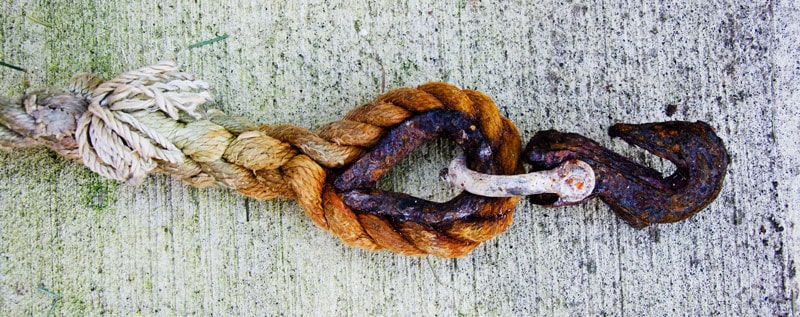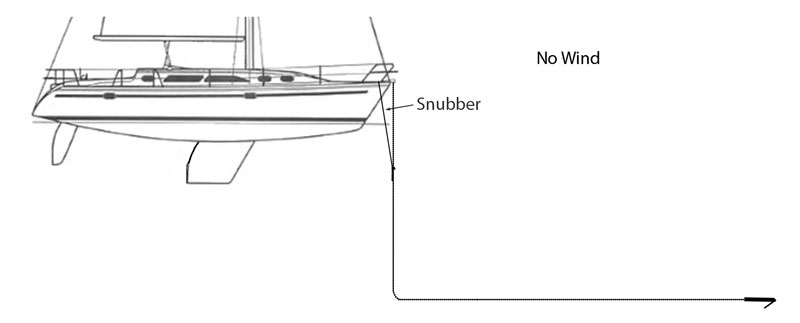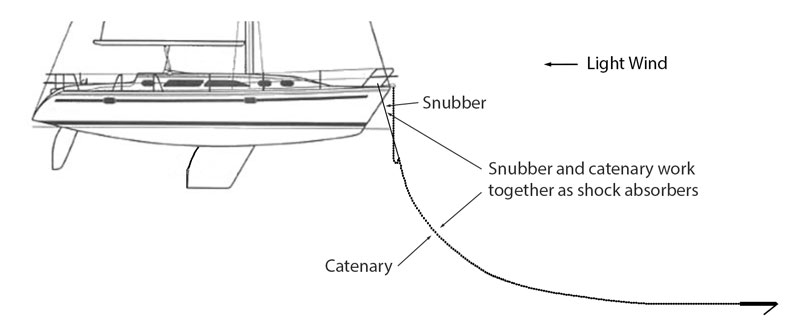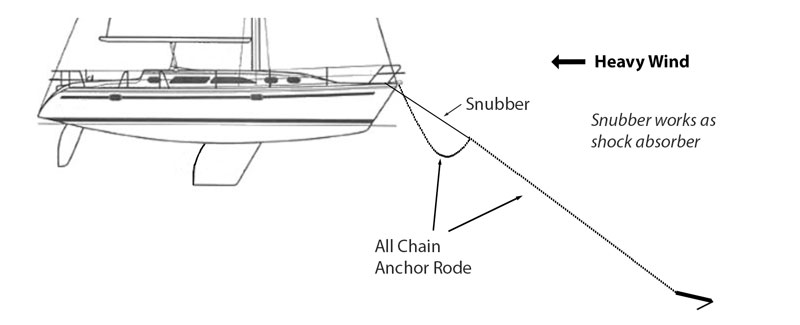An anchor snubber is an elastic line that attaches to a boat's anchor chain on one end and mooring hardware on the deck at the other. An anchor bridle is a snubber with two lines. The snubber or bridle works like a shock absorber in the all-chain ground tackle system.
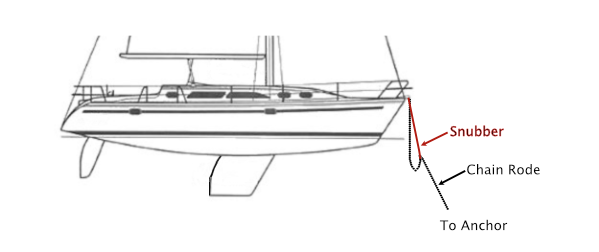
Why Use A Snubber or Bridle?
In a nutshell, snubbers and bridles help prevent snatch loads that are jolting to the crew and destructive to your boat's deck, hardware and windlass. These loads also facilitate anchor drag or can unset your anchor altogether. Snatch loads occur when the forces generated from wind, waves and currents are sufficient to move the boat with enough energy to make the anchor chain taut. Once the chain is tight, the boat decelerates instantaneously and imposes an extraordinary load on the anchor, chain, boat and hardware. Deploying a snubber or bridle into the system reduces or eliminates snatch loads by absorbing much of the associated energy and slowing deceleration. In tight anchorages where optimal scope cannot be achieved, deploying a snubber or bridle can provide an additional layer of protection against anchor drag. Since the chain is less likely to be lifted off the seabed, the anchor shaft is more likely to remain horizontal which is optimal for keeping the anchor set. Bridles can also be used for improving boat motion at anchor.
For those who sleep in a V-berth, snubbers or bridles are important for a good night's rest as they reduce ground tackle related noise, generally, and eliminate the sawing noise made by the chain rolling back-and-forth across the bow roller.
Snubber or Bridle?
For the occasional, fair-weather boater with quick access to protected anchorages, a snubber is probably all you'll ever need as the chances of getting caught in a severe blow are limited. For all others, consider a bridle given a higher likelihood of exposure warrants more robust tackle and the benefits of deploying two legs instead of one. Cruisers should opt for a bridle.
Pros & Cons
Snubbers
- Great for smaller craft
- Sufficient for moderate conditions
- Easy to deploy
- Inexpensive (as compared to a bridle)
- Lightweight
- Lacks redundancy
- Limited ability to improve boat motion
- Great for smaller craft
- Sufficient for moderate conditions
- Easy to deploy
- Inexpensive (as compared to a bridle)
- Lightweight
- Lacks redundancy
- Limited ability to improve boat motion
Bridles
- Best for larger vessels
- Good for all conditions
- Heavy and difficult to deploy in larger sizes and/or longer lengths
- Legs can be adjusted to improve boat motion at anchor
- Load is shared between 2 legs
- At least partial redundancy (bridle design determines degree of redundancy)
- Can be expensive, especially in larger sizes
- Catamarans should use bridles
- Best for larger vessels
- Good for all conditions
- Heavy and difficult to deploy in larger sizes and/or longer lengths
- Legs can be adjusted to improve boat motion at anchor
- Load is shared between 2 legs
- At least partial redundancy (bridle design determines degree of redundancy)
- Can be expensive, especially in larger sizes
- Catamarans should use bridles
Anchor Snubber and Bridle Line Sizes
The optimal line diameter and length for a snubber or bridle is subject to much debate. As stated in other articles on this site, recommendations all too frequently include large line diameters and short leg lengths - snubbers and bridles need to be right-sized to be effective. Manufacturers, experts on this subject and cruisers who anchor out most nights generally lean towards smaller diameters and longer lines. The math bears this out as well. Speaking of math, see our Snubber Size Calculator to estimate the correct snubber or bridle size for your boat.
For another opinion on sizing, Drew Frye created a sizing formula and makes a great case to support it in his article,
"What is
Ideal Snubber Size" in Practical Sailor. For line length, he recommends lengths longer
than the boat up to about 60'. For diameter, he uses the formula:
Snubber diameter (in 1/16 of an inch) = 16 x 0.00067 x (length overall in feet) x
(boat’s loaded weight in pounds)0.3
See his article for more details on length and diameter sizing,
compensation for catamarans and diameter adjustments for bridles.
Sizing Tips
- We repeat this throughout the site: right-sizing is important.
- Consider the length and weight of the vessel when sizing; where sizing tables use length only, size up in diameter if your boat is particularly heavy for its length.
- Boats with high windage (high freeboard, full cabin-top, superstructure, etc) should size up.
- Folks sailing in regions more likely to encounter severe weather (high latitudes, etc.) should size up in diameter and length. Strongly consider a bridle.
- Add length if running your snubber over a bowsprit
- Add length for boats with cleats, bitts or posts mounted well inboard
- Cruisers and others racking up serious sea time should right-size diameter but add length. This group should consider purchasing a second storm bridle.
- Catamaran sizing is different than monohulls; see our Catamaran Anchor Bridles page for details
Buying a Snubber or Bridle
Several companies manufacture anchor snubbers and bridles. Please find a list of them on the Manufacturers page.
Snubber and Bridle Components
For many old salts, tying a rolling hitch with a piece of line and some retired firehose for anti-chafe is all that's needed. There are many who spend 300+ nights a year on the hook and profess this set up is ideal. Whether you opt for this simple method, or a commercially made unit, what's important is sizing it correctly and deploying it regularly. Most commercially available snubbers and bridles will have some variation of the following components:
- Line - nylon is best and 3-strand is most common
- Thimble - stainless steel is better than galvanized; heavy-duty thimbles are preferred for larger, heavier boats
- Shackle - bow shackles are most common - stainless steel and forged are preferable
- Chain hook - there are many on the market; cradle-type, load rated and stainless steel are preferred (see Snubber Bridle Hooks page)
- Anti-chafe - important since chafe can occur rapidly in windy conditions due to near constant boat motion and the loads on lines
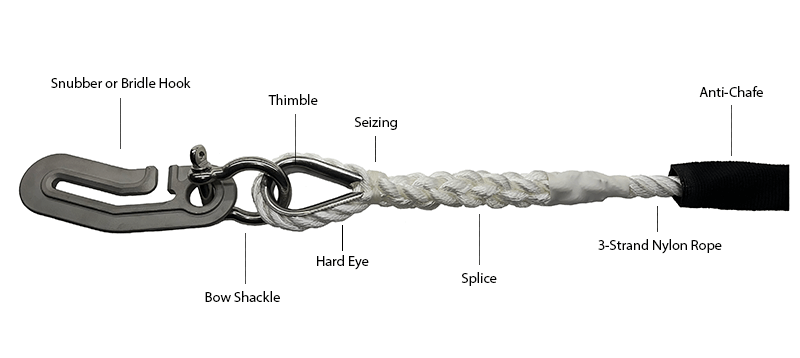
Snubber and Bridle Construction
- Splices - look for 5 - 7 tucks; no less than five
- Hard ("thimbled") eye - look for seizing on the splice adjacent the thimble. Seizing maintains the thimble's position in the eye as the line is stretched.
- Boat end - sufficient melting to prevent unraveling; whipped ends are preferable. Some manufacturers splice in a soft eye.
See our Materials & Construction page for more details on materials and construction
Deploying a Snubber
Deploy the snubber after the anchor is set and desired scope is reached. Follow these basic steps:
- Attach the snubber or bridle to the anchor chain forward of the windlass or after the chain is free of the bow roller
- If using a hook, maintain light tension on the snubber bridle line(s) as you pay out anchor chain to the desired snubber bridle line length.
- Make fast the snubber bridle line(s) to bow cleats.
- Veer additional anchor chain to ensure there's sufficient slack in the chain to allow line(s) to stretch. This step unloads the anchor chain above the hook and loads the snubber bridle line(s).
- Set the chain stopper and unload the windlass
See the How to Deploy a Snubber page for more details on deployment.
Maintenance and Retirement Considerations
Anchor snubbers and bridles require little maintenance aside from rinsing with fresh water after use and limiting exposure to sunlight. We attempt to dry our bridle if we're docked for several days, but the reality is it lives in the anchor locker and is probably wet for 5 - 6 months a year. I do make a point to dry it out in the off-season, in as much as we have one.
Outside of obvious damage, wear or degradation, knowing when to retire a snubber or bridle is a bit elusive. Lines should be replaced after multiple cycles of heavy loading from a storm or after several strong wind events where the line has been subject to regular loading cycles for long periods. Each cycle impacts line strength incrementally and the accumulative effect on overall strength can be significant. It's a bit like the thousand cuts metaphor. Hardware, too, loses strength during cyclic loading; however, the resulting reduction in strength is less than rope. Consider replacing lines when:
- The integrity of the line(s) is compromised due to chafe, deformity, fraying or dry rot
- Lines have been extended beyond 20% of their length due to a severe storm where near-snatch or snatch loads are experienced
- Lines have been subjected to several high wind events and subjected to excessive veering, surging and/or pitching for long periods
- In 1 - 2 seasons for cruisers, fisherpersons, charter boats and other heavily used vessels that anchor frequently
- In 3 - 5 seasons for weekend boaters
- If hardware is damaged from a wind event
Note: Line subjected to severe strain is stiff and somewhat prickly to the hand. This should not be confused with the stiffness associated with old lines and ageing, but it's a sudden rigidity resulting from over-straining. Supple lines deployed before a strong wind event that are stiff when retrieved are suspect and should be evaluated for replacement.
Consider replacing the hardware or hardware components when:
- The hook, shackle or thimble is damaged, rusted or compromised in any way
- If the hardware appears deformed due to stress, replace the entire snubber or bridle
- If you replaced the lines three or more times through regular maintenance and not a significant event, consider replacing the hardware
